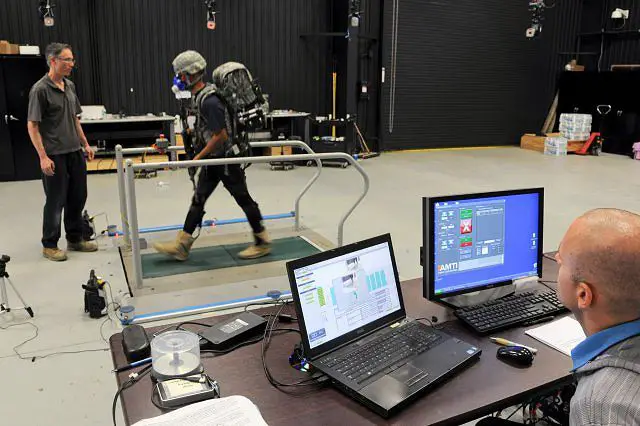United States army researchers to evaluate prototype devices of futuristic soft exosuit 3010144
| a | |||
Military Defense Industry Technology - Futuristic soft exosuit |
|||
| Thursday, October 30, 2014, 06:36 PM | |||
| United States army researchers to evaluate prototype devices of futuristic soft exosuit. | |||
United
States Army researchers are evaluating prototype devices of futuristic
soft exosuit developed for the Defense Advanced Research Projects Agency.
The Defense Advanced Research Projects Agency, known as DARPA, Warrior
Web program's goal is to create a soft, lightweight undersuit to help
reduce injuries and fatigue, while improving mission performance. DARPA
is responsible for the development of new technologies for the U.S. military. |
|||
 Spc. Rafael Boza, a Soldier from the 1st Infantry Division, tests the prototype smart suit on a three-mile course of paved roads and rough terrain at Aberdeen Proving Ground, Md., Oct. 3, 2014. |
|||
| |
|||
Researchers from Harvard University's Wyss Institute for Biologically Inspired Engineering spent the past two years developing a biologically inspired smart suit that aims to boost efficiency through a new approach. A series of webbing straps contain a microprocessor and a network of strain sensors. "The suit mimics the action of leg muscles and tendons so a Soldier's muscles expend less energy," said Dr. Ignacio Galiana, a robotics engineer working on the project. Galiana said the team looked to nature for inspiration in developing cables and pulleys that interact with small motors to provide carefully timed assistance without restricting movement. DARPA selected the U.S. Army Research Laboratory to evaluate several Warrior Web prototypes at the Soldier Performance and Equipment Advanced Research facility, or SPEAR, at Aberdeen Proving Ground. "DARPA was looking for an organization that had experience collecting biomechanics and physiological data on Soldiers in the field, and evaluating Soldier performance for various equipment items," said Dr. Angela Boynton, a mechanical engineer with Army Research Laboratory's Human Research and Engineering Directorate. "We have a unique capability in that we have a biomechanics lab co-located with an obstacle course and a cross-country course, so we're able to collect both lab-based data and field data for the systems." |
|||
 Army researchers evaluate a Defense Advanced Research Projects Agency Warrior Web prototype at the Soldier Performance and Equipment Advanced Research facility, at Aberdeen Proving Ground, Md., Oct. 2, 2014. |
|||
| During testing, Soldiers wear the prototype while carrying battle gear. Researchers capture data as the Soldier walks on an instrumented treadmill that measures how hard the feet hit the ground with each stride. "We're also looking at how they're walking in terms of time and space," Boynton said. "We get things like stride length and stride frequency, and the time that their feet are in contact with the ground. We are also capturing energy expenditure data so we know how many calories they're burning while they're walking on the treadmill with the different conditions. We're also looking at muscle activity, specifically the leg muscles, to look at the amount of muscle work that they're doing while they're performing that task." Army evaluators and the Harvard researchers walked alongside Spc. Rafael Boza, a Soldier from the 1st Infantry Division at Fort Riley, Kansas. Boza tested the prototype Oct. 2, on a three-mile course of paved roads and rough terrain. DARPA also turned to Army researchers during the first phase of Warrior Web prototype development last year. The Army Research Laboratory tested nine devices on Soldiers over a 21-week period. "Most of the devices that they've brought us have been really interesting, and in many cases, did seem to help the Soldiers to some extent," Boynton said. "The level of development from the first round of evaluations to the second round of evaluations has been really impressive, so far. They've addressed a lot of the human factors issues in terms of comfort and fit that we identified in the first round of evaluations, and a lot of the system functionality has been much more streamlined and it's starting to look like a field-ready device, rather than a prototype." Harvard researchers said they hope to help Soldiers to "walk longer distances, keep fatigue at bay and minimize the risk of injury when carrying heavy loads." The Army plans to continue to gather high-resolution, highly controlled data during the prototype evaluation. Another device from the University of Delaware is scheduled to soon be tested here. DARPA's goal is to integrate "multiple mature component technologies into a system potentially wearable by 90 percent of the U.S. Army population, both male and female." |
|||


























